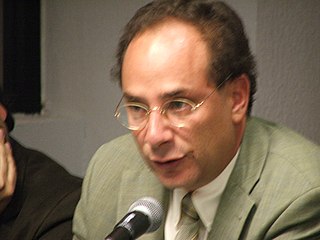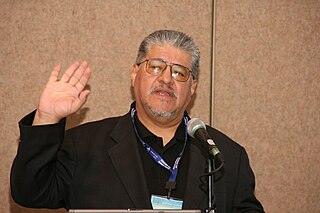
Rudolfo Anaya was an American author. Noted for his 1972 novel Bless Me, Ultima, Anaya was considered one of the founders of the canon of contemporary Chicano and New Mexican literature. The themes and cultural references of the novel, which were uncommon at the time of its publication, had a lasting impression on fellow Latino writers. It was subsequently adapted into a film and an opera.

Puerto Rican literature is the body of literature produced by writers of Puerto Rican descent. It evolved from the art of oral storytelling. Written works by the indigenous inhabitants of Puerto Rico were originally prohibited and repressed by the Spanish colonial government.

Tomás Rivera was a Mexican American author, poet, and educator. He was born in Texas to migrant farm workers, and worked in the fields as a young boy. However, he achieved social mobility through education—earning a degree at Southwest Texas State University, and later a Doctor of Philosophy degree (PhD) at the University of Oklahoma—and came to believe strongly in the virtues of education for Mexican-Americans.

Chicano poetry is a subgenre of Chicano literature that stems from the cultural consciousness developed in the Chicano Movement. Chicano poetry has its roots in the reclamation of Chicana/o as an identity of empowerment rather than denigration. As a literary field, Chicano poetry emerged in the 1960s and formed its own independent literary current and voice.

Ignacio Padilla was a Mexican writer whose works were translated into several languages. Padilla helped found the Crack Movement, along with fellow writers Eloy Urroz, Jorge Volpi, and Pedro Angel Palou, as a means for Mexican authors to find their own voice and write beyond magic realism.

Romeo Rolando Hinojosa-Smith was an American novelist, essayist, poet and the Ellen Clayton Garwood professor in the English Department at the University of Texas at Austin. He was noted for authoring the Klail City Death Trip series of 15 novels written over several decades.

Mexican American literature is literature written by Mexican Americans in the United States. Although its origins can be traced back to the sixteenth century, the bulk of Mexican American literature dates from post-1848 and the United States annexation of large parts of Mexico in the wake of the Mexican–American War. Today, as a part of American literature in general, this genre includes a vibrant and diverse set of narratives, prompting critics to describe it as providing "a new awareness of the historical and cultural independence of both northern and southern American hemispheres". Chicano literature is an aspect of Mexican American literature.
Arte Público Press is a publishing house associated with the University of Houston. It is the largest US publisher of contemporary and recovered literature by US Hispanic authors, publishing approximately 30 titles per year.
Roberta Fernández is a Tejana novelist, scholar, critic and arts advocate. She is known for her novel Intaglio and for her work editing several award-winning women writers. She was a professor in Romance languages & literatures and women's studies at the University of Georgia.
Bilingual Review Press is an American publishing house specialising in the publication of scholarly and literary works by Hispanic and Latino American authors and researchers. It was founded in 1973 as the publisher of The Bilingual Review/La revista bilingüe, a new academic and literary journal with a focus on Spanish-English bilingualism, bilingual studies and Hispanic literature that was first issued in 1974. Under the imprint name Bilingual Press/Editorial Bilingüe the press also publishes and distributes book titles by or about Hispanic and Latin American authors, covering literary fiction, poetry as well as non-fiction titles relating to Chicano and Latin American studies. Bilingual Press publishes from 8 to 10 titles annually, with an accumulated back catalogue of more than 150 titles under the imprint in both English and Spanish as well as some bilingual editions. The publisher is also a distributor of related titles from other presses, as of 2008 numbering over a thousand releases.
Sandra María Esteves is a Latina poet and graphic artist. She was born and raised in the Bronx, New York, and is one of the founders of the Nuyorican poetry movement. She has published collections of poetry and has conducted literary programs at New York City Board of Education, the Caribbean Cultural Center, and El Museo del Barrio. Esteves has served as the executive director of the African Caribbean Poetry Theater. She is the author of Bluestown Mockinbird Mambo and Yerba Buena. She lives in the Bronx.

American literature in Spanish in the United States dates back as 1610 when the Spanish explorer Gaspar Pérez de Villagrá published his epic poem Historia de Nuevo México. He was an early chronicler of the conquest of the Americas and a forerunner of Spanish-language literature in the United States given his focus on the American landscape and the customs of the people. However, it was not until the late 20th century that Spanish language literature written by Americans was regularly published in the United States.
Bernice B. Ortiz Zamora is a Chicana poet, "one of the preeminent poets to emerge from the Chicano movement of the 1960s and 1970s". She received a B.A. in English and French from Southern Colorado State College and an M.A. in English from Colorado State University in Fort Collins in 1972. In 1972, she enrolled in the English doctoral program at Marquette University and transferred to Stanford University the following year, where she ultimately received her Ph.D. in 1976. Besides being an accomplished poet, Zamora also taught classes in ethnic studies, Chicano studies, and literature at Santa Clara University, Stanford University, University of California, and University of San Francisco. She has served as a guest editor and co-editor for various publications, including the Chicano literary journal El Fuego de Aztlán, De Colores with José Armas, Flor y Canto IV with Armas, and Flor y Canto V with Michael Reed.

...y no se lo tragó la tierra is a 1971 Tomás Rivera novel, most recently translated to English as ...And the Earth Did Not Devour Him. It is made up of fourteen short stories and thirteen vignettes. The novel presents stories that center around a community of South Texan Mexican American migrant farm workers during the late 1940s and early 1950s. The novel begins with the short story "A Lost Year", in which an unnamed male protagonist cannot seem to remember what occurred during the previous year. The stories and vignettes that follow are fragmented, lack chronology and lack consistency in characters. The last short story, "Under the House", ties all of these stories together by presenting them as the memories of the male protagonist, who seems to become empowered by the act of remembering. The novel won the Premio Quinto Sol prize for literature in 1970 and has since been adapted into a movie.

Carmen Tafolla is an internationally acclaimed Chicana writer from San Antonio, Texas, and a professor emerita of bicultural bilingual studies at the University of Texas at San Antonio. Tafolla served as the poet laureate of San Antonio from 2012 to 2014, and was named the Poet Laureate of Texas for 2015–16. Tafolla has written more than thirty books, and won multiple literary awards. She is one of the most highly anthologized Chicana authors in the United States, with her work appearing in more than 300 anthologies.
Estela Portillo-Trambley was a Chicana poet and playwright. She gained recognition through the publishing of her many plays, prose, and poetry depicting the lives and plight of Chicana women in male-dominated societies.
Abelardo Barrientos Delgado, aka Lalo, was a Chicano writer, community organizer, and poet. His work was important in establishing the Chicano poetry movement.

Chicano literature is an aspect of Mexican-American literature that emerged from the cultural consciousness developed in the Chicano Movement. Chicano literature formed out of the political and cultural struggle of Chicana/os to develop a political foundation and identity that rejected Anglo-American hegemony. This literature embraced the pre-Columbian roots of Mexican-Americans, especially those who identify as Chicana/os.
La Cucaracha (1976-1983) was an English and Spanish bilingual newspaper created by and for the Chicano community of Pueblo, Colorado. Creators Juan Espinosa, Deborah Espinosa, David Martinez and Pablo Mora recognized the exclusion of Chicanos in popular media and published the first issue in 1976.










